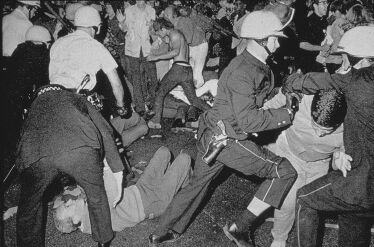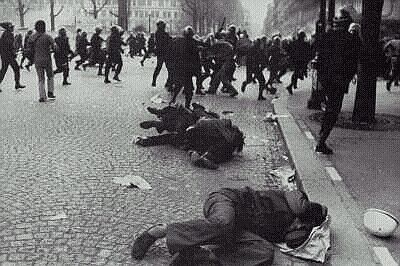The Sixties
|
|
This article deals with the cultural and social aspects and trends of the 1960s. For an detailed list of events, please see 1960s.
The Sixties in its most obvious sense refers to the decade between 1960 and 1969 (see: 1960s), but the expression has taken on a wider meaning over the past 20 years. It has come to refer to the complex of inter-related cultural and political events which occurred in approximately that period, mainly in the United States but also in other western countries, particularly France, West Germany and Britain. Social upheaval was not limited to just these nations, reaching large scale in nations such as Japan and Mexico as well. The term is used both nostalgically by those who participated in those events, and censoriously by those who regard them as a period whose harmful effect are still being felt today.
Popular memory has conflated into "the Sixties" some events which did not actually occur in that decade. The American Civil Rights Movement, for example, began in earnest during the 1950s, although some of its most dramatic events occurred in the early '60s. On the other hand, women's liberation and gay liberation began only in the very late '60s and reached their full flowering in the Seventies. But the term Sixties has become a convenient shorthand for all the new, exciting, radical, subversive and/or dangerous (according to one’s viewpoint) events and trends of the period.
| Contents |
What happened in the Sixties?
Generally, the Sixties is taken to include the following events or trends.
In the United States
The movement for civil and political rights for African Americans (in the early '60s usually called Negroes and in the later '60s Blacks), initially a non-violent movement led by Martin Luther King, Jr. and other Gandhian figures but later producing radical offshoots such as the Black Power movement and competing with the Black Panther Party and the Black Muslims for primacy in the African-American community.
The beginning of what was generally seen as a new political era with the election of President John F. Kennedy in 1960, and its ending in tragedy and disillusionment with Kennedy's assassination in 1963, the assassinations of King and Robert F. Kennedy in 1968, and the collapse of Lyndon Johnson's presidency.
The rise of a mass movement in opposition to the Vietnam War, culminating in the massive Moratorium protests in 1969, and also the movement of resistance to conscription (“the Draft”) for the war. The antiwar movement was initially based on the older 1950s "Peace movement" controlled by the Communist Party USA, but by the mid '60s it outgrew this and became a broad-based mass movement centred on the universities and churches.
Stimulated by this movement, but growing beyond it, the radicalization of large numbers of student-age youth, beginning with the Free Speech Movement at the University of California, Berkeley in 1964, peaking in the riots at the 1968 Democratic National Convention in Chicago and reaching a tragic climax with the shootings at Kent State University in 1970.
The rapid rise of a "New Left," employing the rhetoric of Marxism but having little organizational connection with older Marxist organizations such the Communist Party, and even less connection with the supposed focus of Marxist politics, the organized labor movement, and consisting of ephemeral campus-based Trotskyist, Maoist and anarchist groups, some of which by the end of the 1960s had turned to terrorism.
The overlapping, but somewhat different, movement of youth cultural radicalism manifested by the hippies and the counter-culture, whose emblematic moments were the Summer of Love in San Francisco in 1967 and the Woodstock Festival in 1969.
The rapid spread, associated with this movement, of the recreational use of cannabis and other drugs, particularly new synthetic psychedelic drugs such as LSD.
The breakdown among young people of conventional sexual morality and the flourishing of the sexual revolution. Initially geared mostly to heterosexual male gratification, it soon gave rise to contrary trends, Women's Liberation and Gay Liberation.
The rise of an alternative culture among affluent youth, creating a huge market for rock and blues music produced by drug-culture influenced bands such as The Beatles, Jefferson Airplane and The Doors, and also for radical music in the folk tradition pioneered by Bob Dylan.
In other Western countries
The peak of the student and New Left protests in 1968 coincided with political upheavals in a number of other countries. Although these events often sprang from completely different causes, they were influenced by reports and images of what was happening in the United States and France. Students in Mexico City, for example, protested against the corrupt regime of Gustavo Díaz Ordaz: in the resulting Tlatelolco massacre hundreds were killed.
The influence of American culture and politics in Western Europe, Japan and Australia was already so great by the early 1960s that most of the trends described above soon spawned counterparts in most Western countries. University students rioted in London, Paris, Berlin and Rome, huge crowds protested against the Vietnam War in Australia and New Zealand (both of which had committed troops to the war), and politicians such as Harold Wilson and Pierre Trudeau modelled themselves on John F. Kennedy.
An important difference between the United States and Western Europe, however, was the existence of a mass socialist and/or Communist movement in most European countries (particularly France and Italy), with which the student-based new left was able to forge a connection. The most spectacular manifestation of this was the May 1968 student revolt in Paris, which linked up with a general strike called by the Communist-controlled trade unions and for a few days seemed capable of overthrowing the government of Charles de Gaulle.
In non-Western countries
In Eastern Europe, students also drew inspiration from the protests in the west. In Poland and Yugoslavia they protested against restrictions on free speech by Communist regimes. In Czechoslovakia, 1968 was the year of Alexander Dubček’s Prague Spring, a source of inspiration to many Western leftists who admired Dubček's "socialism with a human face." The Warsaw Pact invasion of Czechoslovakia in August ended these hopes, and also fatally damaged the chances of the orthodox Communist Parties drawing many recruits from the student protest movement.
In the People's Republic of China the mid 1960s were also a time of massive upheaval, and the Red Guard rampages of Mao Zedong's Cultural Revolution had some superficial resemblances to the student protests in the West. The Maoist groups that briefly flourished in the West in this period saw in Chinese Communism a more revolutionary, less bureaucratic model of socialism. Most of them were rapidly disillusioned when Mao welcomed Richard Nixon to China in 1972. People in China, however, saw the Nixon visit as a victory in that they believed the United States would concede that Mao Zedong thought was superior to capitalism (this was the Party stance on the visit in late 1971 and early 1972). The Cuban revolutionary Ernesto "Che" Guevara also became an iconic figure for the student left, although he was in fact an orthodox Communist.
Further Viewing
To see examples of the idealism of the Sixties, view the Woodstock Movie.



